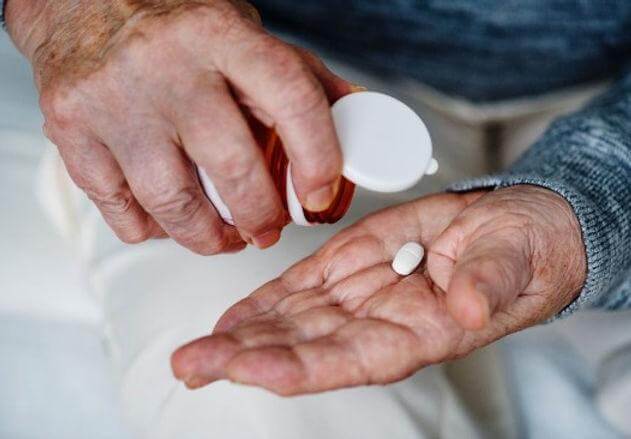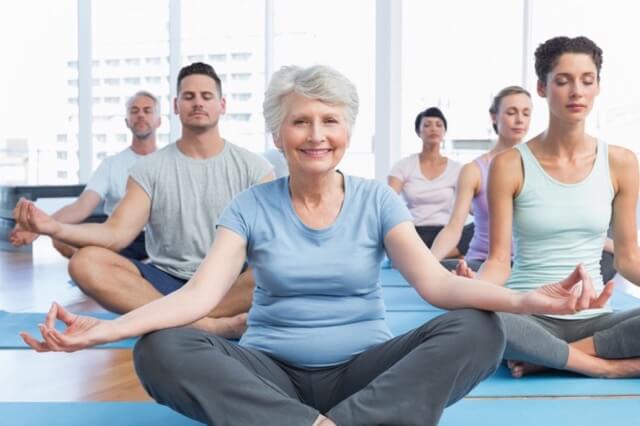Author: Randeep Singh / go to all articles on Yoga cure
Yoga for Osteoporosis:
“Osteo” means bone and “porosis” indicates pores.
Osteoporosis is the condition in which the structure of the bone turns porous due to decrease in the bone mass. This renders the bone brittle, prone to fractures even at the lightest movement, jerk, or fling of a body part.
Human bones are living tissues, contrary to the impression one gets from their stony look. Yoga for osteoporosis can help prevent as well as reverse the condition very effectively.
As with all the other tissues which make different organ system in the body bone tissue has a life span after which it is destroyed and new tissue if formed in its place. Osteoporosis results from the imbalance which creeps in the rate of destruction and the rate of formation of the new tissue, rate of destruction of the bone tissue goes higher than the rate of formation of the new tissue.
Generally individuals of both the sexes who are above 50 years of age are more prone to natural loss of the bone mass, though women especially older women show higher rate of loss of the bone mass as they age further. This is believed to happen due to the loss of the female hormone estrogen after menopause. Estrogen is responsible for maintaining bone health in females.
The worst part of having osteoporosis is that it cannot be detected till one has broken a bone; this is the only indicator which points towards the necessity of the bone density test for proper diagnosis of the condition. Some of the mixed signals about the bones being affected by osteoporosis are mild back pain due to the appearance of light fissures in the vertebrae owing to the weight of the body, loss of some inches in height, and emergence of forward bend in the spine.
The most common parts of the body which are the first to give in to fracture due to osteoporosis are the wrists, hips, and the vertebrae. The rate at which one loses the bone mass in later years in life depends on the health of the bones when one was younger; people who begin exercising from young age are less likely to experience osteoporosis later.
Persons with smaller body frames (less bone tissue) feel the impact of osteoporosis more than s the one’s with larger bones, because smaller frames have lesser reserves of bone mass in the first place to be lost to osteoporosis. Reduction in the secretion of sex hormones in both the sexes (estrogen for women, and testosterone for men) can initiate the disintegration of the bone mass.
Other than age which causes the natural dip in the sex hormones in both the sexes operation of the prostate gland in men and of breast in women can contribute to drop in the sex hormones of both the sexes.
Overactive thyroid, parathyroid or adrenal glands can also cause loss of the bone mass leading to osteoporosis. Osteoporosis can be prevented by taking including adequate amounts of calcium in the diet (Dairy products, green leafy vegetables, soya, orange juice and fish with bones).
Exposure to sunlight also helps to manufacture vitamin D in the body which plays a vital role in the absorption of the calcium into the body during digestion. Fractures due to osteoporosis can prove fatal to the elderly as in most of the cases they do not live past the first year after the fracture has occurred.
Bone tissue can only be formed in the well exercised bones; sedentary lifestyle is one of the most common causes of osteoporosis. Excessive consumption of alcohol and use of tobacco has also been found to have a link with the loss of bone mass in later years.
Yoga for Osteoporosis
Is Yoga good for Osteoporosis? Arthritis is the natural destination of osteoporosis; rather osteoporosis is the main cause of arthritis, this type of arthritis is known as osteoarthritis.

The loss of mass of the bone surfaces which come together at the joints make the movement of the joints difficult and painful as the friction between the two adjoining bones, forming a joint, increases with the wasted bone mass on them. Yoga poses for bone health work by putting more stress on the alignment of the spine.
The yoga asanas which require keeping the spine straight help reduce the kyphosis of the spine which had set in due to osteoporosis. As the bone mass diminishes in the vertebrae they appear to be collapsing over each other, reducing the space in between them which allows for the normal movements of the spine, restricting the free movement of the spine.
One must concentrate on lengthening the spine while doing gentle yoga for osteoporosis as this will benefit by recreating the natural movement facilitating space between the vertebrae. A rigid spine carries high chances of getting fractured at the slightest jerk experienced by it.
Yoga poses for osteoporosis include yoga asanas which brings the weight of the body to bear upon the arms and the hands, this helps build the bone density in the arms and hands of the practitioner.
One can easily prevent osteoporosis with yoga as osteoarthritis treatment with yoga includes gentle back bends which lift eh chest and puts the spine in a slight backward arch. Yoga asanas for correcting the condition of kyphosis when done with less intensity does help by improving the density of the bones which are affected by those movements.
Yoga asanas which are listed here under yoga for arthritis, or yoga for osteoporosis have been structured in a easy flow or vinyasa flow to avoid any jerky movements while one releases one pose and attempts to get in the next one. Most of the fractures for the patients of osteoporosis result from a poor sense of balance, yoga poses for bone health and safety are appropriately interspersed with the poses which challenge the balance of the practitioner.
The balance improvement yoga poses enhance the strength of the center of balance in the brain which proves to be a boon in the later years of life when the sense of balance is the victim of the natural process of ageing. The yoga poses designed for bone health are good for osteoporosis as they deliberately avoid extreme forward bends, extreme backbends, crunches, and sit-ups.
Yoga Poses for Osteoarthritis
Other Informative Articles….

